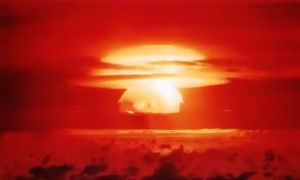Marshall Islands: Difference between revisions
mNo edit summary |
mNo edit summary |
||
| (2 intermediate revisions by 2 users not shown) | |||
| Line 4: | Line 4: | ||
[[File:BombTest.jpg||thumb|right|Mushroom cloud from the Operation Castle Bravo nuclear explosion in the Bikini Atoll, Marshall Islands. Photograph: US air force Photograph: US air force]] | [[File:BombTest.jpg||thumb|right|Mushroom cloud from the Operation Castle Bravo nuclear explosion in the Bikini Atoll, Marshall Islands. Photograph: US air force Photograph: US air force]] | ||
In 1946 the Indigenous inhabints of Bikini Atoll, an island | In 1946 the Indigenous inhabints of Bikini Atoll, an island of the Marshall Islands, were forcibly removed by the [[United States Military]] in order to conduct [[nuclear bomb]] test strikes. One of the tests was the 15-megatonne Bravo test on 1 March 1954 and was a thousand times more powerful than the atomic bomb dropped on Hiroshima- exposing thousands in the surrounding area to radioactive fallout.<Ref>https://www.theguardian.com/world/2014/mar/02/bikini-atoll-nuclear-test-60-years</Ref> In the early 1970's US government scientists declared the island safe for resettlement and some residents were permitted to return. In 1978 residents were, once again, removed from the island after ingesting high levels of radiation from eating foods grown on the former nuclear test site.<Ref>https://phys.org/news/2014-03-islanders-afraid-home-years-bikini.html</Ref> | ||
<Blockquote>US nuclear experiments in the Marshall Islands ended in 1958 after 67 tests. But a United Nations report in 2012 said the effects were long-lasting. Special rapporteur Calin Georgescu, in a report to the UN human rights council, said “near-irreversible environmental contamination” had led to the loss of livelihoods and many people continued to experience “indefinite displacement”.<Ref>https://www.theguardian.com/world/2014/mar/02/bikini-atoll-nuclear-test-60-years</Ref></Blockquote> | <Blockquote>US nuclear experiments in the Marshall Islands ended in 1958 after 67 tests. But a United Nations report in 2012 said the effects were long-lasting. Special rapporteur Calin Georgescu, in a report to the UN human rights council, said “near-irreversible environmental contamination” had led to the loss of livelihoods and many people continued to experience “indefinite displacement”.<Ref>https://www.theguardian.com/world/2014/mar/02/bikini-atoll-nuclear-test-60-years</Ref></Blockquote> | ||
| Line 10: | Line 10: | ||
= Sea Level Rise = | = Sea Level Rise = | ||
In 2017, the US Geological Service published a | In 2017, the US Geological Service published a report on [[sea level rise]] and Pacific atolls, which concluded: | ||
<blockquote>...lowlying atoll islands will be annually flooded by seawater sooner in the future than predicted by the previous efforts that only took sea-level rise inundation into account. Not only will such flooding impact terrestrial infrastructure and habitats, but more importantly, it will make the limited freshwater resources non-potable and thus may force inhabitants relying on groundwater to abandon their island-nations in decades, rather than centuries, as has been previously suggested. <ref = "USGS 2017">Dr. Curt Storlazzi et al., “The Impact of Sea-Level Rise and Climate Change on Department of Defense Installations on Atolls in the Pacific Ocean (RC-2334): U.S. Geological Survey Administrative Report for the U.S. Department of Defense Strategic Environmental Research and Development Program” https://www.serdp-estcp.org/Program-Areas/Resource-Conservation-and-Resiliency/Infrastructure-Resiliency/Vulnerability-and-Impact-Assessment/RC-2334/</ref></blockquote> | <blockquote>...lowlying atoll islands will be annually flooded by seawater sooner in the future than predicted by the previous efforts that only took sea-level rise inundation into account. Not only will such flooding impact terrestrial infrastructure and habitats, but more importantly, it will make the limited freshwater resources non-potable and thus may force inhabitants relying on groundwater to abandon their island-nations in decades, rather than centuries, as has been previously suggested. <ref = "USGS 2017">Dr. Curt Storlazzi et al., “The Impact of Sea-Level Rise and Climate Change on Department of Defense Installations on Atolls in the Pacific Ocean (RC-2334): U.S. Geological Survey Administrative Report for the U.S. Department of Defense Strategic Environmental Research and Development Program” https://www.serdp-estcp.org/Program-Areas/Resource-Conservation-and-Resiliency/Infrastructure-Resiliency/Vulnerability-and-Impact-Assessment/RC-2334/</ref></blockquote> | ||
= Sources = | = Sources = | ||
Latest revision as of 22:29, 6 February 2023
Bikini Atoll
In 1946 the Indigenous inhabints of Bikini Atoll, an island of the Marshall Islands, were forcibly removed by the United States Military in order to conduct nuclear bomb test strikes. One of the tests was the 15-megatonne Bravo test on 1 March 1954 and was a thousand times more powerful than the atomic bomb dropped on Hiroshima- exposing thousands in the surrounding area to radioactive fallout.[1] In the early 1970's US government scientists declared the island safe for resettlement and some residents were permitted to return. In 1978 residents were, once again, removed from the island after ingesting high levels of radiation from eating foods grown on the former nuclear test site.[2]
US nuclear experiments in the Marshall Islands ended in 1958 after 67 tests. But a United Nations report in 2012 said the effects were long-lasting. Special rapporteur Calin Georgescu, in a report to the UN human rights council, said “near-irreversible environmental contamination” had led to the loss of livelihoods and many people continued to experience “indefinite displacement”.[3]
Sea Level Rise
In 2017, the US Geological Service published a report on sea level rise and Pacific atolls, which concluded:
...lowlying atoll islands will be annually flooded by seawater sooner in the future than predicted by the previous efforts that only took sea-level rise inundation into account. Not only will such flooding impact terrestrial infrastructure and habitats, but more importantly, it will make the limited freshwater resources non-potable and thus may force inhabitants relying on groundwater to abandon their island-nations in decades, rather than centuries, as has been previously suggested. [4]
Sources
- ↑ https://www.theguardian.com/world/2014/mar/02/bikini-atoll-nuclear-test-60-years
- ↑ https://phys.org/news/2014-03-islanders-afraid-home-years-bikini.html
- ↑ https://www.theguardian.com/world/2014/mar/02/bikini-atoll-nuclear-test-60-years
- ↑ Dr. Curt Storlazzi et al., “The Impact of Sea-Level Rise and Climate Change on Department of Defense Installations on Atolls in the Pacific Ocean (RC-2334): U.S. Geological Survey Administrative Report for the U.S. Department of Defense Strategic Environmental Research and Development Program” https://www.serdp-estcp.org/Program-Areas/Resource-Conservation-and-Resiliency/Infrastructure-Resiliency/Vulnerability-and-Impact-Assessment/RC-2334/
